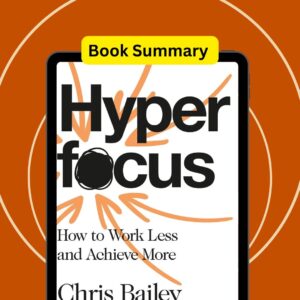Hyperfocus: Summary and Key Insights for Enhanced Productivity
In today’s fast-paced world, the ability to concentrate and maintain focus has become increasingly challenging. Chris Bailey’s book, Hyperfocus: How to Work Less to Achieve More, offers a solution by exploring the concept of hyperfocus—a state of heightened concentration that allows individuals to immerse themselves in tasks and maximize productivity. This blog will provide an in-depth summary of Hyperfocus, examining its key concepts, practical strategies, and the transformative power of focused attention.

Table of Contents
Chris Bailey: A Brief Biography
Chris Bailey is a productivity expert and author known for his insightful exploration of how to optimize time and attention. After spending a year experimenting with productivity techniques, he distilled his findings into actionable advice for readers. His previous works and blog have garnered a substantial following, making him a respected voice in the field of personal development.
The Concept of Hyperfocus
At its core, hyperfocus is about directing your attention toward one specific task while minimizing distractions. Bailey defines hyperfocus as “the ability to concentrate on one thing for an extended period.” This state not only enhances productivity but also fosters creativity and deeper engagement with the task at hand.
The Four Stages of Hyperfocus
Bailey outlines four essential stages to achieve hyperfocus:
- Choose a Meaningful Object of Attention: Start by selecting a task that is both important and meaningful to you. This could be a project at work, a personal goal, or any activity that aligns with your values.
- Eliminate Distractions: Create an environment conducive to focus by removing potential distractions. This includes turning off notifications on devices, closing unnecessary tabs, and informing others of your need for uninterrupted time.
- Focus on Your Task: Dedicate your full attention to the chosen task. This requires mental discipline and commitment to stay engaged with the work without succumbing to external or internal distractions.
- Redirect Your Attention: It’s natural for your mind to wander. When this happens, gently guide your focus back to the task at hand. Developing this skill is crucial for maintaining hyperfocus over longer periods.
The Importance of Intention
Bailey emphasizes that intention must precede attention. By setting clear goals for what you want to accomplish, you create a roadmap that guides your focus throughout the day. This intentional approach helps prioritize tasks and ensures that you remain aligned with your objectives.
Key Themes
1. The Power of Focused Attention
The book illustrates how focused attention can significantly enhance productivity. By concentrating on one task at a time, individuals can complete work more efficiently and with greater accuracy.
2. The Role of Mindfulness
Mindfulness plays a crucial role in achieving hyperfocus. By being present in the moment and fully engaged with the task, individuals can enter a state of flow where they lose track of time and become deeply immersed in their work.
3. Managing Distractions
Bailey provides practical strategies for managing distractions effectively. Recognizing that distractions are inevitable, he encourages readers to proactively create environments that minimize interruptions and foster concentration.
4. Balancing Hyperfocus and Scatterfocus
While hyperfocus is essential for productivity, Bailey also discusses the importance of scatterfocus—allowing your mind to wander creatively. Both modes are crucial; hyperfocus drives execution, while scatterfocus fosters creativity and innovation.
Practical Strategies for Achieving Hyperfocus
1. Implement the Rule of Three
At the beginning of each day, identify three key tasks you want to accomplish. This simple strategy helps prioritize your workload and ensures that you focus on what truly matters.
2. Use Timers
Employ timers or the Pomodoro Technique—working in focused bursts followed by short breaks—to maintain concentration without burning out.
3. Create Rituals
Establishing rituals around your work can signal your brain that it’s time to focus. This could include setting up your workspace or engaging in a brief mindfulness practice before starting tasks.
4. Take Regular Breaks
Bailey emphasizes that taking breaks is essential for maintaining productivity over time. Short breaks allow your mind to recharge and can improve overall focus when you return to work.
5. Reflect on Your Progress
At the end of each day, reflect on what you accomplished and how well you maintained focus throughout your tasks. This self-assessment helps identify patterns and areas for improvement.
Overcoming Challenges
While striving for hyperfocus can lead to increased productivity, challenges may arise:
1. Fear of Missing Out (FOMO)
In an age filled with constant notifications and updates, FOMO can hinder concentration. To combat this, consciously limit social media use during work hours and set specific times for checking messages.
2. Internal Distractions
Thoughts about personal issues or future tasks can disrupt focus. Bailey suggests jotting down distracting thoughts as they arise so you can address them later without losing concentration on your current task.
3. Procrastination
Procrastination often stems from feeling overwhelmed by tasks. To overcome this barrier, break larger projects into smaller, manageable steps that make it easier to get started.
The Impact of Hyperfocus on Creativity
Bailey highlights how hyperfocus not only boosts productivity but also enhances creativity:
- Deep Engagement: When fully engaged in a task, individuals often experience breakthroughs in creative thinking.
- Problem Solving: Hyperfocused states allow for deeper analysis and innovative solutions to complex problems.
- Flow State: Entering a flow state during hyperfocus fosters an environment where creativity thrives without interruptions.
FAQs for Hyperfocus Summary
What is Hyperfocus about?
Hyperfocus: How to Be More Productive in a World of Distraction by Chris Bailey explores the concept of hyperfocus—an intense state of concentration that allows individuals to achieve peak productivity. The book provides strategies for managing attention, minimizing distractions, and optimizing work performance.
Who is the author of the book?
The author, Chris Bailey, is a productivity expert and speaker known for his research on time management and focus. He has written extensively on productivity and has experimented with various techniques to enhance personal efficiency.
What are the main themes of the book?
Key themes include:
- The Science of Attention: Understanding how attention works and its impact on productivity.
- Managing Distractions: Strategies to minimize interruptions and stay focused.
- Achieving Hyperfocus: Techniques to enter a state of deep concentration for enhanced creativity and output.
How is the book structured?
The book is divided into two main sections: the first focuses on understanding hyperfocus and its benefits, while the second provides practical strategies for achieving and maintaining this state. Each chapter includes actionable tips and real-life examples.
What can readers expect to learn from this book?
Readers can expect to learn how to:
- Cultivate hyperfocus to improve productivity.
- Identify and eliminate distractions in their environment.
- Balance periods of hyperfocus with relaxation to avoid burnout.
Who would benefit from reading this book?
Hyperfocus is ideal for professionals, students, and anyone seeking to enhance their productivity in a distraction-filled world. It appeals to individuals interested in personal development and effective time management.
Are there any specific techniques mentioned in the book?
Yes, Bailey outlines several techniques, including:
- Time-blocking for focused work sessions.
- The Pomodoro Technique for managing work intervals.
- Mindfulness practices to improve attention control.
How does this book differ from other productivity books?
While many productivity books focus on general time management strategies, Hyperfocus specifically delves into the psychology of attention and offers a unique framework for achieving deep concentration. It emphasizes the importance of understanding how our brains work to maximize productivity.
Is there a practical application for the concepts discussed?
Absolutely! The strategies provided can be easily implemented in daily routines, helping readers create environments conducive to focus, manage their time effectively, and ultimately enhance their overall productivity.
Conclusion
Hyperfocus: How to Work Less to Achieve More by Chris Bailey serves as an essential guide for anyone seeking to enhance their productivity through focused attention. By understanding the principles behind hyperfocus and implementing practical strategies, readers can reclaim their time and energy while achieving their goals more efficiently.As we navigate an increasingly distracted world, mastering hyperfocus becomes vital not just for professional success but also for personal fulfillment. By prioritizing meaningful tasks, eliminating distractions, and fostering both focused and creative thinking, we can transform our approach to work and life itself.




